UiO-66-(COOH)2 Decorated Collagen Fiber Membranes for High-Efficiency Separation of Cationic Surfactant-Stabilized Oil/Water Emulsions: Toward Sustainable and Robust Wastewater Treatment
Abstract
1. Introduction
2. Materials and Methods
2.1. Materials
2.2. Preparation of CFM- UiO-66-(COOH)2
2.3. Preparation of Cationic O/W Emulsions
2.4. Emulsion Separation
2.5. Abrasion Resistance, Acid and Alkali Stability, Biocompatibility Evaluation of CFM-UiO-66-(COOH)2
2.6. Characterization
3. Results and Discussion
3.1. Characterization of the CFM-UiO-66-(COOH)2
3.2. Separation Performance Analysis of CFM-UiO-66-(COOH)2 for Cationic O/W Emulsions
3.3. Antifouling Evaluation of CFM-UiO-66-(COOH)2
3.3.1. Reusability of CFM-UiO-66-(COOH)2
3.3.2. Acid and Alkali Resistance Analysis of CFM-UiO-66-(COOH)2
3.3.3. Abrasion Resistance Analysis of CFM-UiO-66-(COOH)2
3.3.4. Biosafety Evaluation of CFM-UiO-66-(COOH)2
3.4. Demulsification and Separation Mechanism of CFM-UiO-66-(COOH)2
4. Conclusions
Supplementary Materials
Author Contributions
Funding
Institutional Review Board Statement
Informed Consent Statement
Data Availability Statement
Conflicts of Interest
References
- Zhang, N.; Yang, X.; Wang, Y.; Qi, Y.; Zhang, Y.; Luo, J.; Cui, P.; Jiang, W. A review on oil/water emulsion separation membrane material. J. Environ. Chem. Eng. 2022, 10, 107257. [Google Scholar] [CrossRef]
- Abuhasel, K.; Kchaou, M.; Alquraish, M.; Munusamy, Y.; Jeng, Y.T. Oily Wastewater Treatment: Overview of Conventional and Modern Methods, Challenges, and Future Opportunities. Water 2021, 13, 980. [Google Scholar] [CrossRef]
- Zhang, W.; Liu, N.; Cao, Y.; Lin, X.; Liu, Y.; Feng, L. Superwetting Porous Materials for Wastewater Treatment: From Immiscible Oil/Water Mixture to Emulsion Separation. Adv. Mater. Interfaces 2017, 4, 1600029. [Google Scholar] [CrossRef]
- Bhoj, Y.; Tharmavaram, M.; Rawtani, D. A comprehensive approach to antifouling strategies in desalination, marine environment, and wastewater treatment. Chem. Phys. Impact 2021, 2, 100008. [Google Scholar] [CrossRef]
- Peng, Y.; Guo, Z. Recent advances in biomimetic thin membranes applied in emulsified oil/water separation. J. Mater. Chem. A 2016, 4, 15749–15770. [Google Scholar] [CrossRef]
- Luo, T.; Wang, H.; Chen, L.; Li, J.; Wu, F.; Zhou, D. Visible light-driven oxidation of arsenite, sulfite and thiazine dyes: A new strategy for using waste to treat waste. J. Clean. Prod. 2021, 280, 124374. [Google Scholar] [CrossRef]
- Guha, I.F.; Varanasi, K.K. Separating nanoscale emulsions: Progress and challenges to date. Curr. Opin. Colloid Interface Sci. 2018, 36, 110–117. [Google Scholar] [CrossRef]
- Zhang, W.; Liu, N.; Cao, Y.; Chen, Y.; Xu, L.; Lin, X.; Feng, L. A Solvothermal Route Decorated on Different Substrates: Controllable Separation of an Oil/Water Mixture to a Stabilized Nanoscale Emulsion. Adv. Mater. 2015, 27, 7349–7355. [Google Scholar] [CrossRef]
- Aguirre-Ramírez, M.; Silva-Jiménez, H.; Banat, I.M.; Díaz De Rienzo, M.A. Surfactants: Physicochemical interactions with biological macromolecules. Biotechnol. Lett. 2021, 43, 523–535. [Google Scholar] [CrossRef] [PubMed]
- Kumar Shah, S.; Chakraborty, G.; Bhattarai, A.; De, R. Synergistic and antagonistic effects in micellization of mixed surfactants. J. Mol. Liq. 2022, 368, 120678. [Google Scholar] [CrossRef]
- Samiey, B.; Cheng, C.-H.; Wu, J. Effects of Surfactants on the Rate of Chemical Reactions. J. Chem. 2014, 2014, 908476. [Google Scholar] [CrossRef]
- Danov, K.D.; Kralchevsky, P.A.; Ananthapadmanabhan, K.P. Micelle–monomer equilibria in solutions of ionic surfactants and in ionic–nonionic mixtures: A generalized phase separation model. Adv. Colloid Interface Sci. 2014, 206, 17–45. [Google Scholar] [CrossRef]
- Han, M.; Zhang, J.; Chu, W.; Chen, J.; Zhou, G. Research Progress and Prospects of Marine Oily Wastewater Treatment: A Review. Water 2019, 11, 2517. [Google Scholar] [CrossRef]
- Vialkova, E.; Obukhova, M.; Belova, L. Microwave Irradiation in Technologies of Wastewater and Wastewater Sludge Treatment: A Review. Water 2021, 13, 1784. [Google Scholar] [CrossRef]
- Tanrikulu, I.C.; Westler, W.M.; Ellison, A.J.; Markley, J.L.; Raines, R.T. Templated Collagen “Double Helices” Maintain Their Structure. J. Am. Chem. Soc. 2020, 142, 1137–1141. [Google Scholar] [CrossRef] [PubMed]
- He, X.; Wang, Y.-n.; Zhou, J.; Wang, H.; Ding, W.; Shi, B. Suitability of Pore Measurement Methods for Characterizing the Hierarchical Pore Structure of Leather. J. Am. Leather Chem. Assoc. 2019, 114, 41–47. [Google Scholar]
- Liao, X.; Lu, Z.; Shi, B. Selective adsorption of tannins onto hide collagen fibres. Sci. China Ser. B Chem. 2003, 46, 495–504. [Google Scholar] [CrossRef]
- Zhang, X.; Gao, M.; Zhang, C.; Peng, B. Enzymatic processes for animal hide/skin collagen fiber purification processing: Recent progress, challenges and recommendations. Bioresour. Technol. 2024, 418, 131955. [Google Scholar] [CrossRef] [PubMed]
- Ahn, H.; Gong, D.J.; Lee, H.H.; Seo, J.Y.; Song, K.M.; Eom, S.J.; Yeo, S.Y. Mechanical properties of porcine and fish skin-based collagen and conjugated collagen fibers. Polymers 2021, 13, 2151. [Google Scholar] [CrossRef]
- Maggay, I.V.; Chang, Y.; Venault, A.; Dizon, G.V.; Wu, C.-J. Functionalized porous filtration media for gravity-driven filtration: Reviewing a new emerging approach for oil and water emulsions separation. Sep. Purif. Technol. 2021, 259, 117983. [Google Scholar] [CrossRef]
- Li, B.; Qi, B.; Guo, Z.; Wang, D.; Jiao, T. Recent developments in the application of membrane separation technology and its challenges in oil-water separation: A review. Chemosphere 2023, 327, 138528. [Google Scholar] [CrossRef]
- Li, H.; Wang, X.; He, Y.; Peng, L. Facile preparation of fluorine-free superhydrophobic/superoleophilic paper via layer-by-layer deposition for self-cleaning and oil/water separation. Cellulose 2018, 26, 2055–2074. [Google Scholar] [CrossRef]
- Scharnberg, A.R.A.; Oliveira, H.A.; Weschenfelder, S.E.; Rubio, J.; Azevedo, A.C. Flocculation of emulsified oil-in-water with dodecylbenzene sulfonate and polyacrylamide and floc separation by dissolved air flotation. Colloids Surf. A 2023, 669, 131496. [Google Scholar] [CrossRef]
- Peng, X.; Hu, F.; Zhang, T.; Qiu, F.; Dai, H. Amine-functionalized magnetic bamboo-based activated carbon adsorptive removal of ciprofloxacin and norfloxacin: A batch and fixed-bed column study. Bioresour. Technol. 2018, 249, 924–934. [Google Scholar] [CrossRef]
- Zolfaghari, R.; Fakhru’l-Razi, A.; Abdullah, L.C.; Elnashaie, S.S.E.H.; Pendashteh, A. Demulsification techniques of water-in-oil and oil-in-water emulsions in petroleum industry. Sep. Purif. Technol. 2016, 170, 377–407. [Google Scholar] [CrossRef]
- Wang, Y.; He, Y.; Yu, J.; Zhang, L.; Li, S.; Li, H. Alginate-based nanofibrous membrane with robust photo-Fenton self-cleaning property for efficient crude oil/water emulsion separation. Sep. Purif. Technol. 2022, 287, 120569. [Google Scholar] [CrossRef]
- Sousa, A.M.; Pereira, M.J.; Matos, H.A. Oil-in-water and water-in-oil emulsions formation and demulsification. J. Pet. Sci. Eng. 2022, 210, 110041. [Google Scholar] [CrossRef]
- Bu, X.; Lu, Y.; Chen, S.; Li, D.; Zhang, Z.; Qian, P. Fabrication of porous carbon nitride foams/acrylic resin composites for efficient oil and organic solvents capture. Chem. Eng. J. 2019, 355, 299–308. [Google Scholar] [CrossRef]
- Li, S.; Han, W.; An, Q.F.; Yong, K.T.; Yin, M.J. Defect engineering of MOF-based membrane for gas separation. Adv. Funct. Mater. 2023, 33, 2303447. [Google Scholar] [CrossRef]
- Lorignon, F.; Gossard, A.; Medjouel, S.; Carboni, M.; Meyer, D. Controlling polyHIPE surface properties by tuning the hydrophobicity of MOF particles stabilizing a pickering emulsion. ACS Appl. Mater. Interfaces 2023, 15, 30707–30716. [Google Scholar] [CrossRef]
- Chen, C.; Fei, L.; Wang, B.; Xu, J.; Li, B.; Shen, L.; Lin, H. MOF-based photocatalytic membrane for water purification: A review. Small 2024, 20, 2305066. [Google Scholar] [CrossRef] [PubMed]
- Fan, F.; Zhao, L.; Guo, Y.; Xu, H.; Wang, T.; Fu, Y. Fabrication of a ZIF-8/PVA Membrane on PVDF Fiber by Spray for the Highly Efficient Separation of Oil-in-Water Emulsions. ACS Appl. Mater. Interfaces 2024, 16, 54548–54554. [Google Scholar] [CrossRef]
- Gao, J.; Cai, M.; Nie, Z.; Zhang, J.; Chen, Y. Superwetting PVDF membrane prepared by in situ extraction of metal ions for highly efficient oil/water mixture and emulsion separation. Sep. Purif. Technol. 2021, 275, 119174. [Google Scholar] [CrossRef]
- He, S.; Zhan, Y.; Hu, J.; Zhang, G.; Zhao, S.; Feng, Q.; Yang, W. Chemically stable two-dimensional MXene@UIO-66-(COOH)2 composite lamellar membrane for multi-component pollutant-oil-water emulsion separation. Compos. Part B Eng. 2020, 197, 108188. [Google Scholar] [CrossRef]
- Wu, J.; Hou, Z.; Yu, Z.; Lang, J.; Cui, J.; Yang, J.; Dai, J.; Li, C.; Yan, Y.; Xie, A. Facile preparation of metal-polyphenol coordination complex coated PVDF membrane for oil/water emulsion separation. Sep. Purif. Technol. 2021, 258, 118022. [Google Scholar] [CrossRef]
- Zhong, X.; Shi, Q.; Guo, Z. Synergistic Construction of Superhydrophilic PVDF Membranes by Dual Modification Strategies for Efficient Emulsion Separation. Small 2024, 20, 2402538. [Google Scholar] [CrossRef] [PubMed]
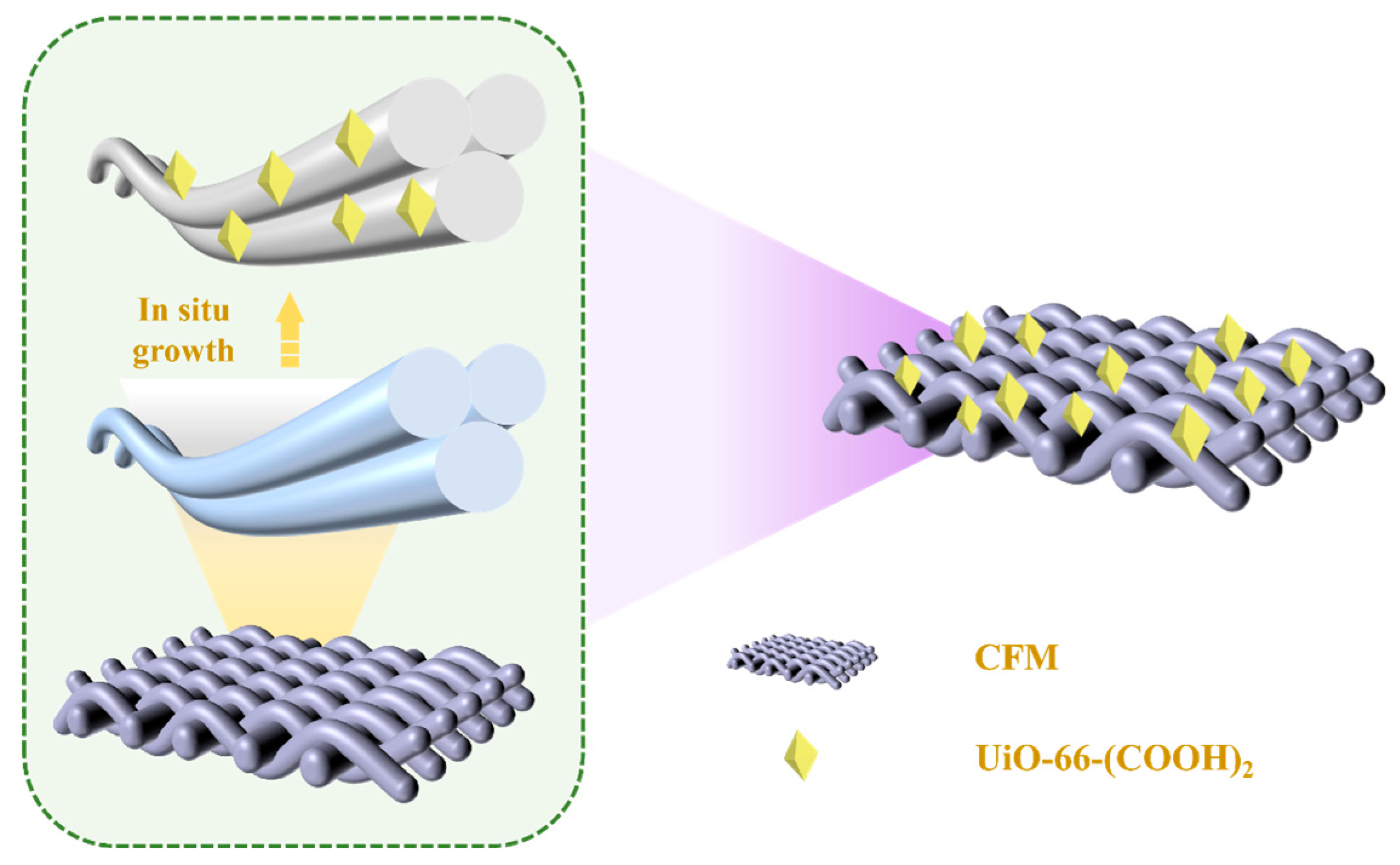
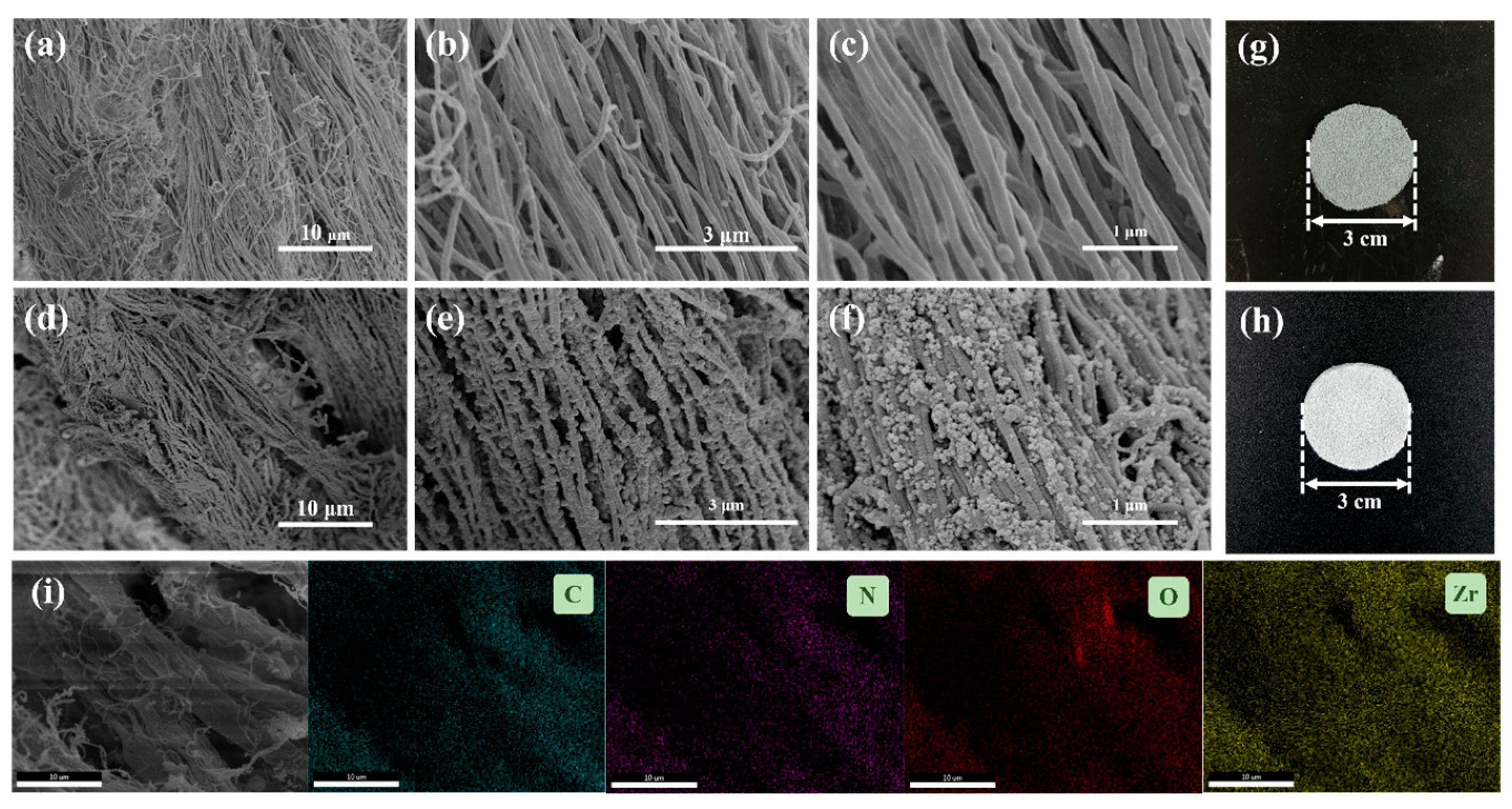
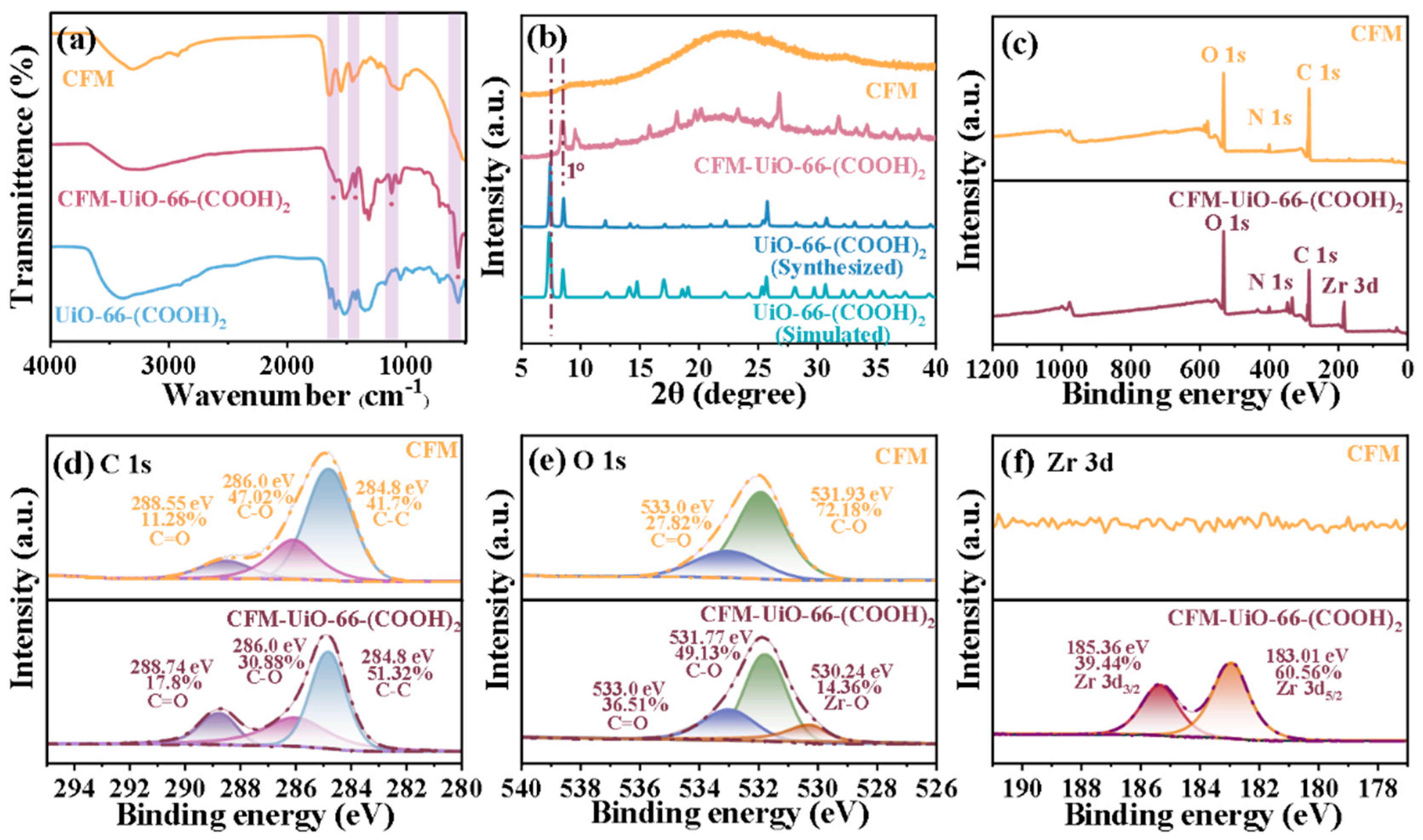
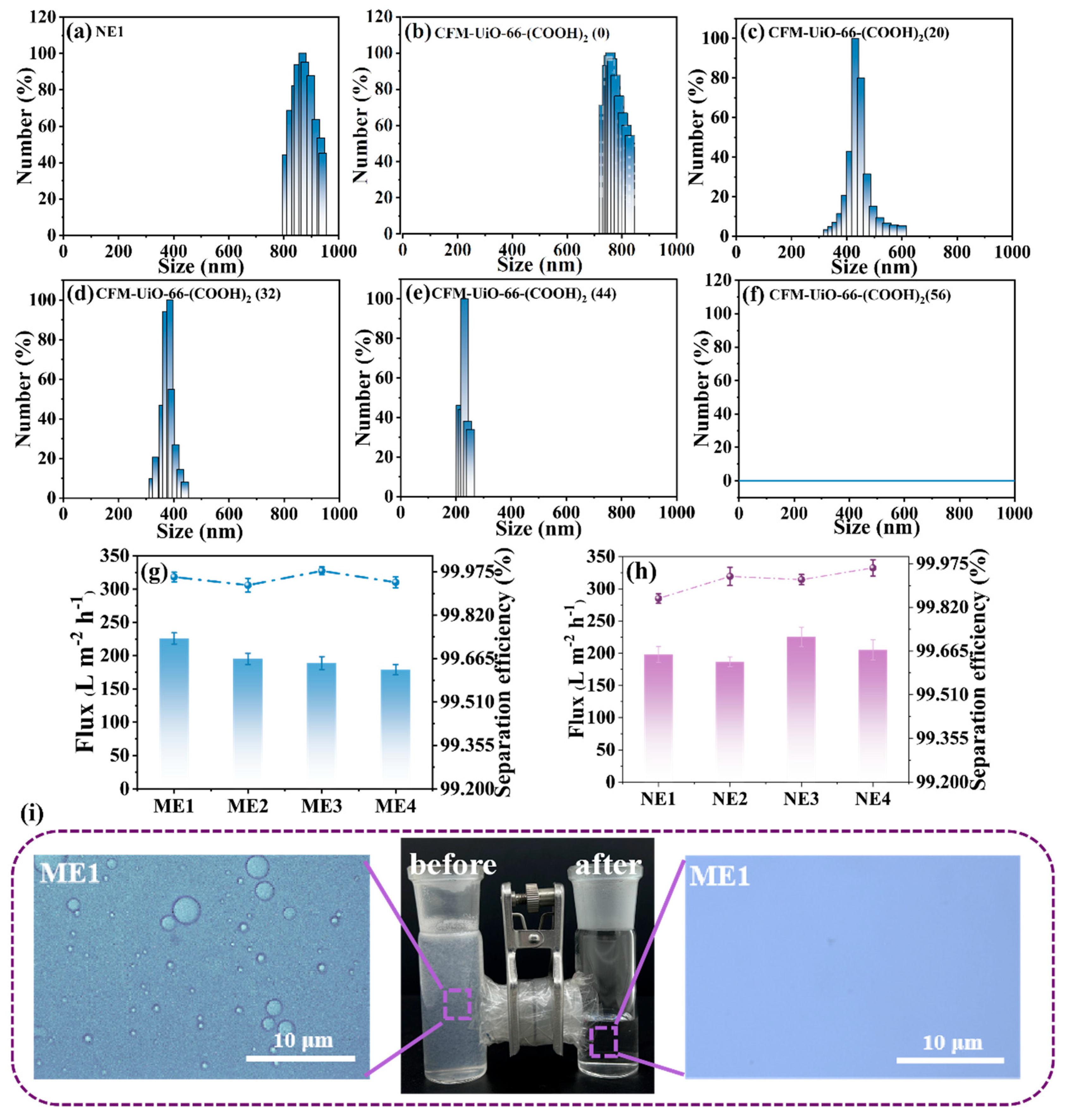
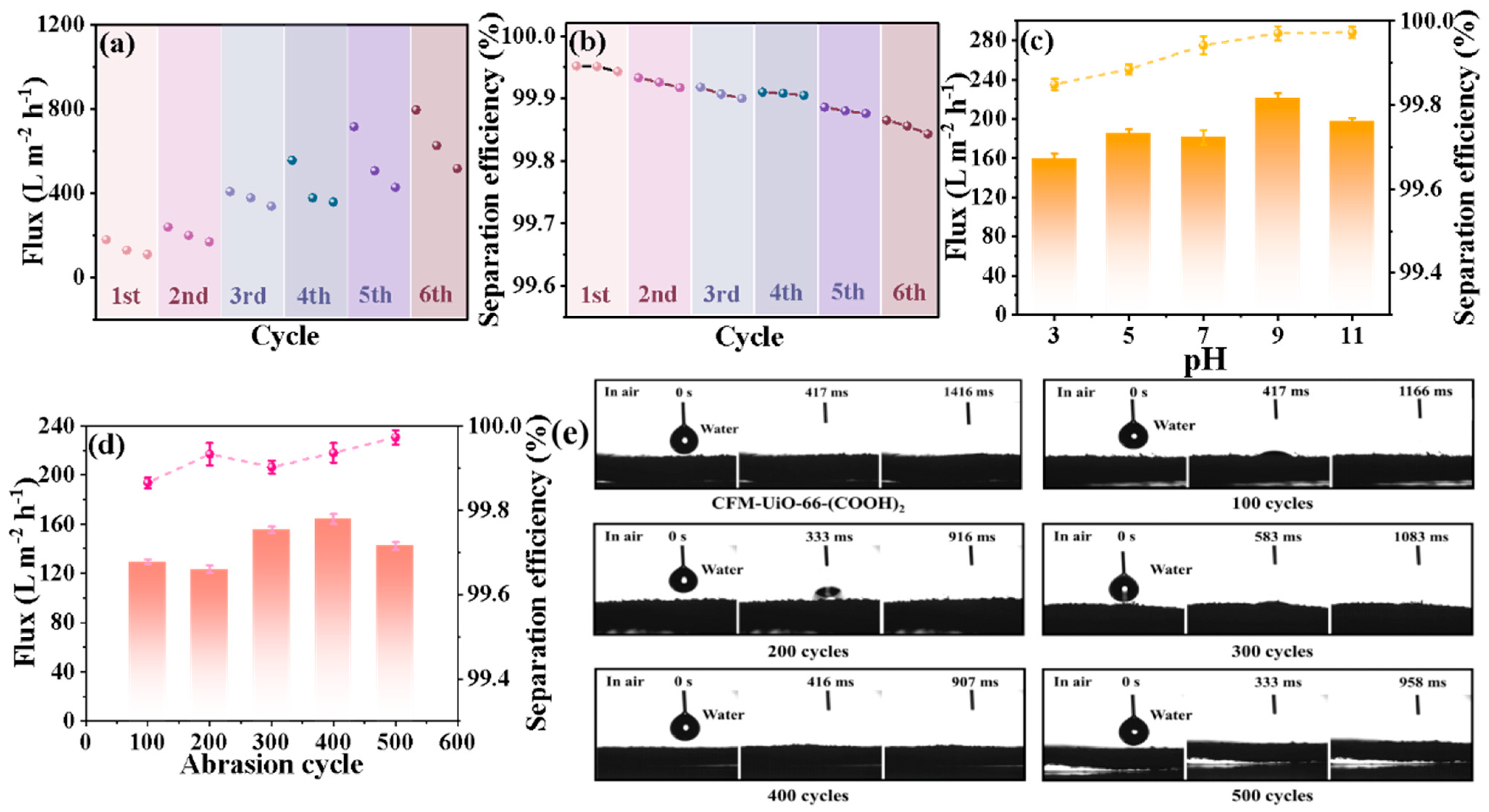

Disclaimer/Publisher’s Note: The statements, opinions and data contained in all publications are solely those of the individual author(s) and contributor(s) and not of MDPI and/or the editor(s). MDPI and/or the editor(s) disclaim responsibility for any injury to people or property resulting from any ideas, methods, instructions or products referred to in the content. |
© 2025 by the authors. Licensee MDPI, Basel, Switzerland. This article is an open access article distributed under the terms and conditions of the Creative Commons Attribution (CC BY) license (https://creativecommons.org/licenses/by/4.0/).
Share and Cite
Yang, G.; Wu, Q.; Xiao, G.; Ye, X. UiO-66-(COOH)2 Decorated Collagen Fiber Membranes for High-Efficiency Separation of Cationic Surfactant-Stabilized Oil/Water Emulsions: Toward Sustainable and Robust Wastewater Treatment. Polymers 2025, 17, 2879. https://doi.org/10.3390/polym17212879
Yang G, Wu Q, Xiao G, Ye X. UiO-66-(COOH)2 Decorated Collagen Fiber Membranes for High-Efficiency Separation of Cationic Surfactant-Stabilized Oil/Water Emulsions: Toward Sustainable and Robust Wastewater Treatment. Polymers. 2025; 17(21):2879. https://doi.org/10.3390/polym17212879
Chicago/Turabian StyleYang, Guifang, Qiu Wu, Gao Xiao, and Xiaoxia Ye. 2025. "UiO-66-(COOH)2 Decorated Collagen Fiber Membranes for High-Efficiency Separation of Cationic Surfactant-Stabilized Oil/Water Emulsions: Toward Sustainable and Robust Wastewater Treatment" Polymers 17, no. 21: 2879. https://doi.org/10.3390/polym17212879
APA StyleYang, G., Wu, Q., Xiao, G., & Ye, X. (2025). UiO-66-(COOH)2 Decorated Collagen Fiber Membranes for High-Efficiency Separation of Cationic Surfactant-Stabilized Oil/Water Emulsions: Toward Sustainable and Robust Wastewater Treatment. Polymers, 17(21), 2879. https://doi.org/10.3390/polym17212879







